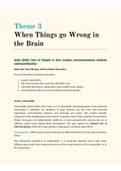Samenvatting
3.6C The Brain Theme 3: When Things Go Wrong in the Brain (Summary)
- Vak
- Instelling
Complete summary of the literature for 3.6C "The Brain" Theme 1: Brain Basics for the Psychology "Brain and Cognition" specialisation. The summary covers the following book chapters: - Stahl (2000): 1. Part of Chapter 4: How synaptic neurotransmission mediates emotional disorders (pg. 105 �...
[Meer zien]






